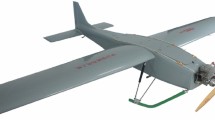Abstract
This article presents a miniature robotic plane meteorological sounding system (RPMSS), which consists of three major subsystems: a miniature robotic plane, an air-borne meteorological sounding and flight control system, and a ground-based system. Take-off and landing of the miniature aircraft are guided by radio control, and the flight of the robotic plane along a pre-designed trajectory is automatically piloted by an onboard navigation system. The observed meteorological data as well as all flight information are sent back in real time to the ground, then displayed and recorded by the ground-based computer. The ground-based subsystem can also transmit instructions to the air-borne control subsystem. Good system performance has been demonstrated by more than 300 hours of flight for atmospheric sounding.
Similar content being viewed by others
References
Holland, G. J., T. McGeer, and H. Youngren, 1992: Autonomous aerosondes for economical atmospheric soundings anywhere on the globe.Bull. Amer. Meteor. Soc.,73(12), 1987–1998.
Holland, G. J., and Coauthors, 2001: The Aerosonde robotic aircraft: A new paradigm for environmental observations.Bull. Amer. Meteor. Soc.,82(5), 889–901.
Junkermann, W., 2001: An ultralight aircraft as platform for research in the lower troposphere: System performance and first results from radiation transfer studies in stratiform aerosol layers and broken cloud conditions.J. Atmos. Oceanic. Technol.,18, 934–946.
Ma Shuqing, Wang Gai, and Pan Yi, 1997: Preliminary experiments of atmospheric sounding using Mini Unmanned Air Vehicle.Journal of Nanjing Meteorology Institute,20(2), 171–177. (in Chinese)
Ma Shuqing, Wang Gai, Pan Yi, and Wang Ling, 1999: An analytical method for wind measurement using miniature aircraft.Chinese J. Atmos. Sci.,23(2), 202–208.
Marenco, A., and Coauthors, 1998: Measurement of ozone and water vapor by airbus in-service aircraft: The MOZAIC airborne program, an overview.J. Geophys. Res.,103(D19), 25631–25642.
Moninger, W. R., R. D. Mamrosh, and P. M. Pauley, 2003: Automated meteorological reports from commercial aircraft.Bull. Amer. Meteor. Soc.,84(2), 203–216.
Scott, S. G., T. P. Bui, and K. R. Chan, 1990: The meteorological measurement system on the NASA ER-2 aircraft.J. Atmos. Oceanic. Technol.,7(4), 525–540.
Author information
Authors and Affiliations
Rights and permissions
About this article
Cite this article
Shuqing, M., Hongbin, C., Gai, W. et al. A miniature robotic plane meteorological sounding system. Adv. Atmos. Sci. 21, 890–896 (2004). https://doi.org/10.1007/BF02915591
Received:
Revised:
Issue Date:
DOI: https://doi.org/10.1007/BF02915591




